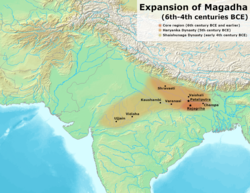| Shishunaga Dynasty | |||||||||||||
|---|---|---|---|---|---|---|---|---|---|---|---|---|---|
| 413 BCE–345 BCE | |||||||||||||
 Approximate extent of the Shisshunaga dynasty. Approximate extent of the Shisshunaga dynasty. | |||||||||||||
| Capital | Rajgir (primary) Vaishali (secondary) later Pataliputra | ||||||||||||
| Common languages | Sanskrit Magadhi Prakrit Other Prakrits | ||||||||||||
| Religion | Brahmanism Buddhism Jainism | ||||||||||||
| Government | Monarchy | ||||||||||||
| King | |||||||||||||
| • 413–395 BCE | Shishunaga | ||||||||||||
| • 395–367 BCE | Kalashoka | ||||||||||||
| • 367–355 BCE | Nandivardhana | ||||||||||||
| • 355–345 BCE | Mahanandin | ||||||||||||
| History | |||||||||||||
| • Established | 413 BCE | ||||||||||||
| • Disestablished | 345 BCE | ||||||||||||
| |||||||||||||
The Shishunaga dynasty (IAST: Śaiśunāga, literally "of Shishunaga") was the second ruling dynasty of Magadha. According to the Hindu Puranas, this dynasty was the second ruling dynasty of Magadha, succeeding Nagadashaka of the Haryanka dynasty.
History
Shishunaga, the founder of the dynasty. He was initially an amatya or "minister" of the last Haryanka dynasty ruler Nāgadāsaka and ascended to the throne after a popular rebellion in c. 413 BCE.
The capital of this dynasty initially was Vaishali; but later shifted to Pataliputra, near the present day Patna, during the reign of Kalashoka.
According to tradition, Kalashoka was succeeded by his ten sons. This dynasty was succeeded by the Nanda dynasty in c. 345 BCE.
Rulers
Shishunaga
Main article: ShishunagaShishunaga founded his dynasty in 413 BCE with its capital in Rajgir and later Pataliputra (both in what is now Bihar). Buddhist sources indicate that he had a secondary capital at Vaishali, formerly the capital of Vajji, until it was conquered by Magadha. The Shaishunaga dynasty ruled one of the largest empires in the Indian subcontinent. Shishunaga ended the Pradyota dynasty of Avanti, ending the centuries old rivalry between their kingdoms and annexing Avanti into Magadha.
Kakavarna/Kalashoka
Main article: KalashokaAccording to the Puranas, Shishunaga was succeeded by his son Kakavarna and according to the Sinhala chronicles by his son Kalashoka. On the basis of the evidence of the Ashokavadana, Hermann Jacobi, Wilhelm Geiger and Ramakrishna Gopal Bhandarkar concluded that both are the same. During Shishunaga's reign, he was the governor of Varanasi. The two most significant events of his reign are the Second Buddhist council at Vaishali in 383 BC and the final transfer of the capital to Pataliputra. According to the Harshacharita, he was killed by a dagger thrust into his throat in the vicinity of his capital. According to Buddhist tradition, he had nine or ten sons, who were ousted by Ugrasena Nanda.
Later rulers
According to Buddhist tradition, ten sons of Kalashoka ruled simultaneously. The Mahabodhivamsa states their names as Bhadrasena, Korandavarna, Mangura, Sarvanjaha, Jalika, Ubhaka, Sanjaya, Koravya, Nandivardhana and Panchamaka. Only one of them is mentioned in the Puranic lists, Nandivardhana.
According to the Bhagavata Purana, Kākavarṇa was succeeded by seven kings and lists them as following; Kṣemadharmā, Kṣetrajña, Vidhisāra, Ajātaśatru, Darbhaka, Ajaya, Nandivardhana, and Mahanandin.
Other Puranas list Nandivardhana as the ninth Shaishunaga king and his son Mahanandin as the tenth and the last Shaishunaga king. Mahanandin was killed by Mahapadma, his illegitimate son .

Decline
According to Puranas, Shaishunagas were followed by the Nanda dynasty, which was founded by Mahanandin's son Mahapadma Nanda.
Citations
- Schwartzberg, Joseph E. (1978). A Historical atlas of South Asia. Chicago: University of Chicago Press. p. 145, map XIV.1 (a). ISBN 0226742210.
- Upinder Singh 2016, p. 273.
- Singh, Upinder (2008). A History of Ancient and Early Medieval India: From the Stone Age to the 12th Century. Pearson Education India. p. 272. ISBN 978-81-317-1120-0.
...the people of Magadha drove out the ruling family and elected an amatya (a high-ranking official) named Shishunaga as king. Shishunaga seems to have had a second capital at Vaishali (according to the Mahavamsatika, he was the son of a Lichchhavi raja of Vaishali). He succeeded in destroying the power of the Pradyota dynasty of Avanti.
- Raychaudhuri 1972, pp. 193, 201.
- ^ Raychaudhuri 1972, p. 196.
- Raychaudhuri 1972, p. 201.
- ^ Upinder Singh 2016, p. 272.
- Raychaudhuri 1972, pp. 195–196.
- Mahajan 2007, p. 251.
- Sastri 1988, p. 14.
- Mookerji 1988, p. 10.
Sources
- Mookerji, Radha Kumud (1988) , Chandragupta Maurya and his times (4th ed.), Motilal Banarsidass, ISBN 978-81-208-0433-3
- Singh, Upinder (2016), A History of Ancient and Early Medieval India: From the Stone Age to the 12th Century, Pearson PLC, ISBN 978-81-317-1677-9
- Raychaudhuri, H.C. (1972), Political History of Ancient India, Calcutta: University of Calcutta
- Sastri, K. A. Nilakanta, ed. (1988) , Age of the Nandas and Mauryas (Second ed.), Delhi: Motilal Banarsidass, ISBN 978-81-208-0465-4
- Mahajan, V.D. (2007) , Ancient India, New Delhi: S. Chand, ISBN 978-81-219-0887-0
| Preceded byHaryanka dynasty (Magadha) Pradyota dynasty (Avanti) | Shaishunaga Dynasty 413–345 BCE |
Succeeded byNanda Dynasty |
| Middle kingdoms of India | |||||||||||||||||||||||||||||||||||||||||||||||||||||||||||||||||||||||||||||||||||||||||||||||||||||||||||||||||||||||||||||||||||||||||||||||||||||||||||||||||||||||||||||
|---|---|---|---|---|---|---|---|---|---|---|---|---|---|---|---|---|---|---|---|---|---|---|---|---|---|---|---|---|---|---|---|---|---|---|---|---|---|---|---|---|---|---|---|---|---|---|---|---|---|---|---|---|---|---|---|---|---|---|---|---|---|---|---|---|---|---|---|---|---|---|---|---|---|---|---|---|---|---|---|---|---|---|---|---|---|---|---|---|---|---|---|---|---|---|---|---|---|---|---|---|---|---|---|---|---|---|---|---|---|---|---|---|---|---|---|---|---|---|---|---|---|---|---|---|---|---|---|---|---|---|---|---|---|---|---|---|---|---|---|---|---|---|---|---|---|---|---|---|---|---|---|---|---|---|---|---|---|---|---|---|---|---|---|---|---|---|---|---|---|---|---|---|---|
| |||||||||||||||||||||||||||||||||||||||||||||||||||||||||||||||||||||||||||||||||||||||||||||||||||||||||||||||||||||||||||||||||||||||||||||||||||||||||||||||||||||||||||||